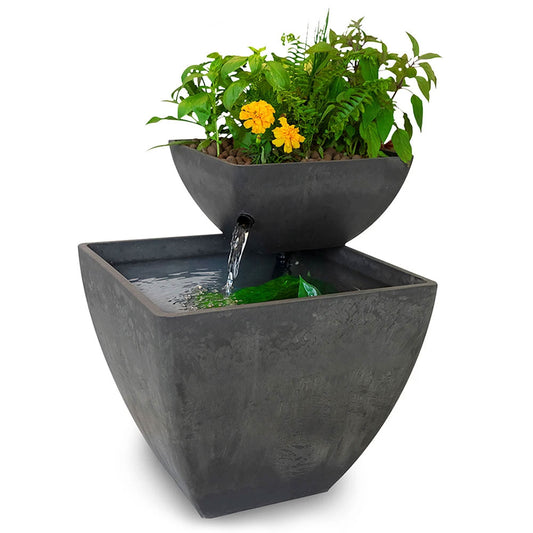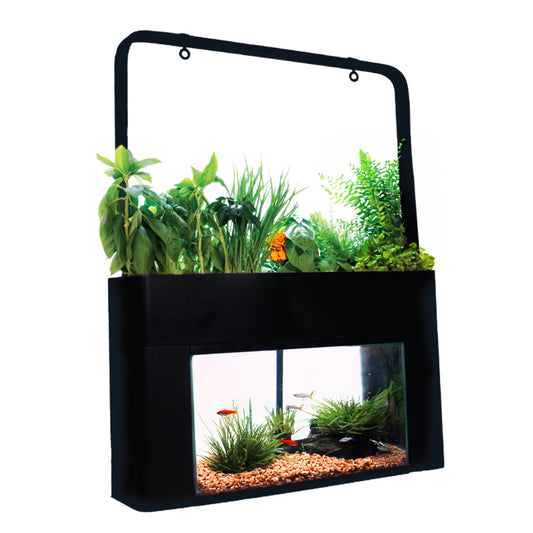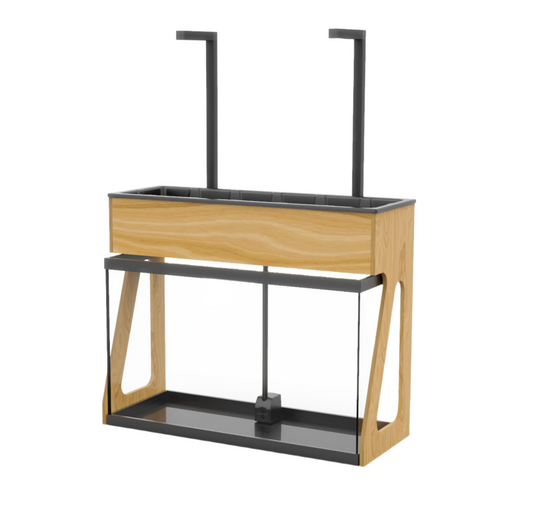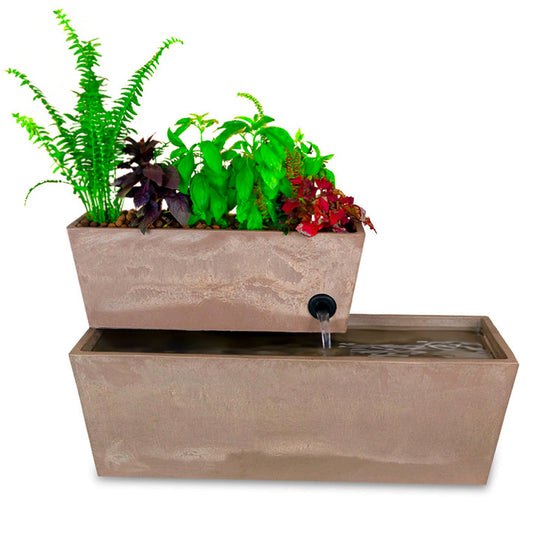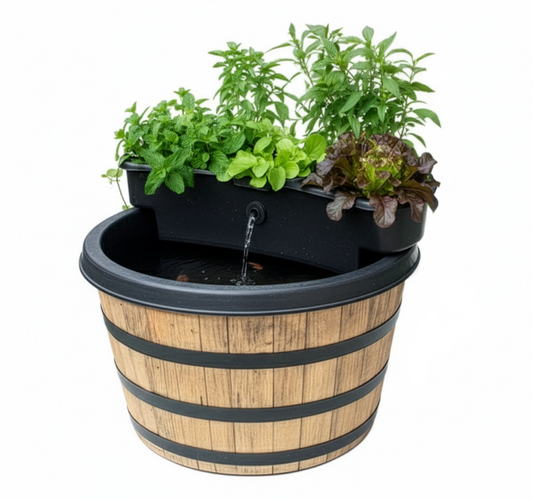Aquaponics Low-Maintenance Guide
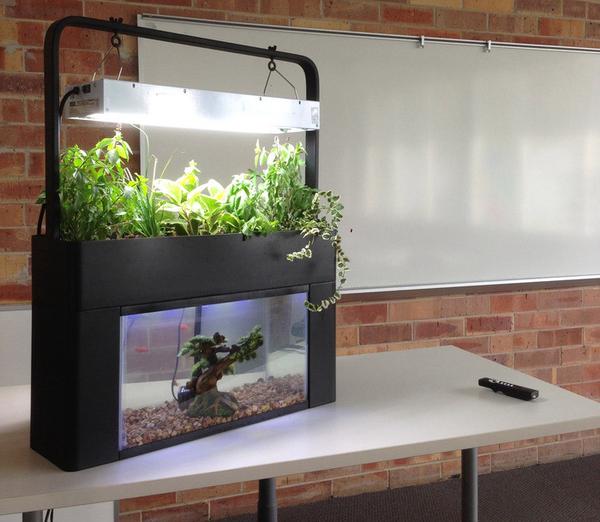
We get a lot of questions from folks who would love to get into aquaponics - or even just keep an aquarium - but for a variety of reasons, they simply don’t have much time or energy to devote to upkeep. Today, we’re going to look at the bare minimums - and it may surprise you how little you have to do to keep a healthy, beautiful aquaponic garden!
Aquaponics 101
There are a lot of great sources out there for beginner info on aquaponics. Our support center features a number of articles on all sorts of topics, so we won’t rehash all that here. Instead, we’ll take you through a quick overview of what the basic needs of an aquaponic system are, and how you can manage those needs with the least effort and expense. In some cases, a little extra work at the outset can save you a tremendous amount of trouble down the line!
So, your Garden is unboxed and set up (our handy how-to video can help). Like it says in the manual, you’re ready to go! You can begin cycling your tank (Cycling a new system is unavoidably going to be one of the trickiest parts of keeping any aquarium or aquaponic garden, but our cycling guide and cycling kit can make it a little bit easier) and working your way up to a virtually maintenance-free system!
So what about accessories? What do you need, and what’s just an upgrade?
- Lights: A dedicated grow light is very helpful for growing crops, or for gardens which don’t receive much light otherwise. However, there are plenty of ways to keep a Garden without a light, by taking advantage of natural light, or growing shade-tolerant ornamental plants. (More on plant selection below)
- Heaters: Since most small aquarium fish are tropical in origin, keeping the temperature of your water consistent is usually necessary. If the tank sits in an environment which stays within acceptable temperature ranges (75-85F), you may be able to skip the heater. However, modern aquarium heaters are small, cheap, and some even come preset so you all you need to do is plug them in and drop them into the tank. It’s one extra piece of hardware, but it’s a small up-front investment that will save you trouble in the long run.
- Air Pumps: An air pump is a great way to perk up struggling fish and give your system a healthy boost, but it also makes extra noise and requires extra setup. As long as you don’t overstock your tank (more on fish selection below), the ebb and flow of the Garden should provide enough water flow and aeration. Like air pumps, separate filters can be a nice addition to a system, but aren’t necessary as long as your tank isn’t overpopulated.
- Water Test Kits: You won’t necessarily need a full “master” testing set, but at the very least, we strongly recommend a pH test. Other water chemistry variables will stabilize with time, but pH is the one you’ll always need to be able to check and manage.
- Water Chemistry Adjustments: As long as you’ve got good source water, you should be able to manage most water quality problems with water changes. We've selected the AquaSprouts clay pebble medium to help minimize the amount of adjustment you'll need to do; using purified water or spring water to fill your aquarium and top it off when water evaporates will eliminate the need for most adjustments. Howrver, chemicals can save you some trouble if you find yourself repeatedly facing water issues like chronically low pH, and it's good to have the basics - pH increasers and decreasers - on hand.
Populating Your Garden
Once the Garden is set up and filled, most new aquaponic gardeners can’t wait to get to the exciting part - the living, growing components! Of course, life is also complicated, so this is where it’s easy to go wrong. Choosing fish and plants that will be hardy, undemanding, and easy to care for can make all the difference between a Garden that needs daily care and one that will run beautifully for weeks at a time with nothing but feeding and water top-offs.
First off, some unavoidable facts: the more you want your Garden to produce, the more you’re going to have to put into it - more time, more money, more effort. If you’re looking for the absolute easiest aquaponic garden you can have, you’re going to have to make some tradeoffs, like keeping ornamental plants instead of crops, and keeping a smaller number of fish. Fortunately, there are ways to make things easier no matter what you want to do!
Growing food: Food plants are specially cultivated to grow large and fast! That means they’ll need plenty of light and nutrition. For most food crops, you’ll need a separate grow light or a very sunny spot, and you’ll need to feed them a lot, which means stocking up on fish. Heavy fish populations also mean you’ll probably want extra filtration and aeration, and that you’ll want to test more water parameters, more often, because if anything goes wrong, it’ll go wrong a lot faster. More nutritional needs means they’re also sensitive to conditions which affect nutrient uptake, including a variety of water chemistry variables.
The easiest food crops to grow tend to be greens, rather than fruiting plants like peppers or tomatoes. Salad mixes and lettuce are very simple to grow and generally don’t require as much light or nutrition as most other vegetables. They need to be harvested often or they become bitter or go to seed, but that’s perfect for eating regular fresh salads!
 Herb gardens: Culinary herbs can be a nice compromise between growing food and keeping a purely ornamental garden. Many herbs can grow into robust perennial plants, and once they reach this mature stage, they require little care and provide a great, convenient way to keep fresh herbs on hand without even having to step outside. Many varieties of basil, sage, mint, oregano, and others will thrive in an aquaponic garden.
Herb gardens: Culinary herbs can be a nice compromise between growing food and keeping a purely ornamental garden. Many herbs can grow into robust perennial plants, and once they reach this mature stage, they require little care and provide a great, convenient way to keep fresh herbs on hand without even having to step outside. Many varieties of basil, sage, mint, oregano, and others will thrive in an aquaponic garden.
Ornamental plants: Many varieties of houseplants are selected specifically to be tolerant of low light conditions and require little maintenance. Devil’s ivy, ferns, arrow plants, kalanchoe, and a variety of other attractive plants will grow happily in an aquaponic garden with almost no effort from you, as long as they receive at least moderate daily light from a window or bright overhead fixtures. The only real drawback is that, since most of these plants tend to grow slowly, they won’t absorb nutrients at the same rate as food crops, which means you won’t be able to keep as dense a population of fish without the water becoming polluted and unhealthy. Be aware, also, that getting plants to flower can be much trickier than just keeping them alive, so pick a plant that looks good in and out of bloom!
So what about animals? Well, one great way to learn more about what kind of fish you’d like to keep is to visit an aquarium or specialty pet shop. The associates at a big box pet store may or may not know a lot about fish, but if you can find a smaller store that specializes in aquariums, you’ll almost always find people working there who love fish and have a wealth of knowledge to share. Just tell them what you’re trying to do and let them show off! To give you a place to start, here are some basic guidelines for selecting fish:
-
The maximum population of your tank is a function of the (full-grown) size of your fish and how many of them you’re keeping. In general, with small fish, it’s best not to exceed 1” of total fish length per gallon of tank, which in this case means a
 total nose-to-tail length of adult fish of about 10”. Many common aquarium fish grow to an adult size close to 2”, so a school of 5 or so would be ideal. Make sure you know how big the fish you want are going to get!
total nose-to-tail length of adult fish of about 10”. Many common aquarium fish grow to an adult size close to 2”, so a school of 5 or so would be ideal. Make sure you know how big the fish you want are going to get!
- For most fish, their natural behavior and comfort - which has a powerful effect on their health and longevity - requires that they be in a school of at least 4-5 fish of the same or a closely related, similar species.
- Some fish are aggressive and don’t make good tankmates with others. Some fish come from very unusual water conditions and won’t be able to live in the same water that makes other fish happy. Make sure you know a little bit about different species of fish before you mix them together. (Or ask someone who does!)
- A few common varieties of fish that work well in small to medium aquariums: mollies, platies, most barbs (cherry, tiger, checkerboard, etc.), many tetras (neon, lemon, skirt, silver, bloodfin, and many more), rubberlip or bristlenose varieties of plecostomus (commonly called suckerfish or algae eaters), danios (zebra, leopard, Glofish), dwarf or pygmy corydoras catfish
- Some common varieties to avoid for a ten-gallon tank: goldfish (They don’t actually stop growing naturally - their adult size is around 8” long and they can live for many years! If they get too cramped, though, they generally live a much shorter, less healthy life.), common plecostomus & tinfoil barbs (also much too large), angelfish & most other cichlids (mostly too large and aggressive), most catfish (too large)
- Interesting options beyond fish: So-called “mystery” snails and the smaller nerite snails require virtually no extra care and can even help clean the tank of waste buildup and algae. Ghost shrimp or cherry shrimp make a fun and easy addition to an established tank - they also need no special care. (Watch out for small snails with spiraled conical shells. They may be Malaysian trumpet snails, a prolific pest which is very difficult to eradicate.)
Maintenance
 We strongly recommend you check out our setup how-to video and our cycling guide, in the AquaSprouts Support Center. No matter how problem-free your Garden can eventually be, you’re going to have to get through the awkward initial setup period during the first few weeks before the system stabilizes. We’ve collected a lot of great information for you to make this process as smooth and simple as possible in our other guides, so we won’t spend much time here rehashing it - just know that cycling is a little more difficult and management-intensive than normal operation, but we’ve got you covered! Once your tank is cycled and you’ve got your Garden stocked and planted, there should only be a few things you’ll have to do beyond feeding your fish and, if you’re growing food, harvesting and replanting.
We strongly recommend you check out our setup how-to video and our cycling guide, in the AquaSprouts Support Center. No matter how problem-free your Garden can eventually be, you’re going to have to get through the awkward initial setup period during the first few weeks before the system stabilizes. We’ve collected a lot of great information for you to make this process as smooth and simple as possible in our other guides, so we won’t spend much time here rehashing it - just know that cycling is a little more difficult and management-intensive than normal operation, but we’ve got you covered! Once your tank is cycled and you’ve got your Garden stocked and planted, there should only be a few things you’ll have to do beyond feeding your fish and, if you’re growing food, harvesting and replanting.
One useful trick to keep in mind first: most pet stores and aquarium stores will perform basic water testing for free or a small charge, if you don’t want to purchase and keep around a full test kit yourself. Take them a small (½ cup) water sample and they can help you with most water- related issues you might have.
We recommend testing pH (a measure of acidity or basicity) at least once a week. Knowing your pH can tell you a lot about your aquarium water! It’s also important to keep track of and adjust the pH itself. Here are the most important things to know about pH:
- Fish and plants are adapted to specific pH ranges and need to stay in a comfortable pH to thrive. For small aquaponic systems, a pH of slightly below neutral is preferred. Neutral is 7.0, so keeping your water slightly acidic (6.6-6.8) will keep most fish happy and allow your plants the best access to nutrients in the water.
- The normal operation of your biofilter, the bacteria that live in your Garden and do most of the work of processing toxic fish waste into plant food, will cause pH to decrease (acidify) over time. This means you may occasionally need to adjust pH upward. You can use our AquaSprouts pH Kit, or pH adjustment products from your local pet or aquarium shop, or you can simply perform partial water changes if your source water is slightly alkaline. (Note: During cycling, your pH may actually drift upward because of the composition of the AquaSprouts clay pebble media. It will generally stay within a safe range for most fish but may go high enough to impair plant growth. You can adjust it downward chemically or perform water changes with purified water to reduce it.)
- If you find that your pH is consistently low (< 6.2), it likely means that you have a lot of biological activity in your system - lots of food going in, lots of waste getting processed. If this is the case, consider testing your nitrate levels. Plants can only use up nutrients so fast, and if you have lots and lots of nutrients going in, they may be accumulating as nitrate faster than the plants can take them up. Nitrate is not highly toxic under normal conditions, but high levels of nitrate can poison your fish over time. If you are accumulating nitrate, you may need to reduce the amount you feed your fish, or perform occasional partial water changes to help remove the excess. (Increasing the amount of light your plants receive can also help reduce nitrate by speeding up plant growth!)
This may seem like a lot to take in all at once, but your Garden is designed with stability in mind. A little diligence in the first few weeks will get you well on your way to a beautiful, thriving Garden system that only needs food, water-top offs, and the occasional check-up. And finally, if you ever feel lost, or if you have any questions or concerns, get in touch. We're here to help!

 total nose-to-tail length of adult fish of about 10”. Many common aquarium fish grow to an adult size close to 2”, so a school of 5 or so would be ideal. Make sure you know how big the fish you want are going to get!
total nose-to-tail length of adult fish of about 10”. Many common aquarium fish grow to an adult size close to 2”, so a school of 5 or so would be ideal. Make sure you know how big the fish you want are going to get!